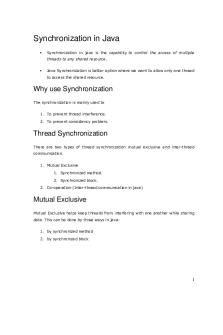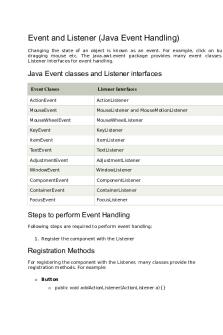Multithreading in Java PDF

| Title | Multithreading in Java |
|---|---|
| Author | Sakshi Bhalothia |
| Course | Java Programming |
| Institution | Banasthali Vidyapith |
| Pages | 12 |
| File Size | 263.2 KB |
| File Type | |
| Total Downloads | 39 |
| Total Views | 342 |
Summary
Multithreading in Java1] Multithreading in java is a process of executing multiple threads simultaneously. 2] Thread is basically a lightweight sub-process, a smallest unit of processing. Multiprocessing and multithreading, both are used to achieve multitasking. 3] But we use multithreading than mul...
Description
Multithreading in Java 1] Multithreading in java is a process of executing multiple threads simultaneously. 2] Thread is basically a lightweight sub-process, a smallest unit of processing. Multiprocessing and multithreading, both are used to achieve multitasking. 3] But we use multithreading than multiprocessing because threads share a common memory area. They don't allocate separate memory area so saves memory, and context-switching between the threads takes less time than process. 4] Java Multithreading is mostly used in games, animation etc. Advantage of Java Multithreading 1) It doesn't block the user because threads are independent and you can perform multiple operations at same time. 2) You can perform many operations together so it saves time. 3) Threads are independent so it doesn't affect other threads if exceptions occur in a single thread. Multitasking Multitasking is a process of executing multiple tasks simultaneously. We use multitasking to utilize the CPU. Multitasking can be achieved by two ways: 1] Process-based Multitasking (Multiprocessing) 2] Thread-based Multitasking (Multithreading)
1] Process-based Multitasking (Multiprocessing)
Each process has its own address in memory i.e. each process allocates separate memory area.
Process is heavyweight.
Cost of communication between the processes is high.
Switching from one process to another require some time for saving and loading registers, memory maps, updating lists etc.
1
2] Thread-based Multitasking (Multithreading)
Threads share the same address space.
Thread is lightweight.
Cost of communication between the thread is low. Note: At least one process is required for each thread.
What is Thread in java A thread is a lightweight sub process, a smallest unit of processing. It is a separate path of execution. Threads are independent, if there occurs exception in one thread, it doesn't affect other threads. It shares a common memory area.
Figure shows, thread is executed inside the process. There is context-switching between the threads. There can be multiple processes inside the OS and one process can have multiple threads.
Life cycle of a Thread (Thread States) 2
A thread can be in one of the five states. According to sun, there is only 4 states in thread life cycle in java new, runnable, non-runnable and terminated. There is no running state. But for better understanding the threads, we are explaining it in the 5 states. The life cycle of the thread in java is controlled by JVM. The java thread states are as follows: 1] New 2] Runnable 3] Running 4] Non-Runnable (Blocked) 5] Terminated
3
1) New The thread is in new state if you create an instance of Thread class but before the invocation of start() method. 2) Runnable The thread is in runnable state after invocation of start() method, but the thread scheduler has not selected it to be the running thread. 3) Running The thread is in running state if the thread scheduler has selected it. 4) Non-Runnable (Blocked) This is the state when the thread is still alive, but is currently not eligible to run. 5) Terminated A thread is in terminated or dead state when its run() method exits.
How to create thread There are two ways to create a thread: 1. By extending Thread class 2. By implementing Runnable interface. Thread class: Thread class provide constructors and methods to create and perform operations on a thread.Thread class extends Object class and implements Runnable interface.
Commonly used Constructors of Thread class:
Thread()
Thread(String name)
Thread(Runnable r)
Thread(Runnable r,String name)
4
Commonly used methods of Thread class: 1. public void run(): is used to perform action for a thread. 2. public void start(): starts the execution of the thread.JVM calls the run() method on the thread. 3. public void sleep(long miliseconds): Causes the currently executing thread to sleep (temporarily cease execution) for the specified number of milliseconds. 4. public void join(): waits for a thread to die. 5. public void join(long miliseconds): waits for a thread to die for the specified miliseconds. 6. public int getPriority(): returns the priority of the thread. 7. public int setPriority(int priority): changes the priority of the thread. 8. public String getName(): returns the name of the thread. 9. public void setName(String name): changes the name of the thread. 10. public Thread currentThread(): returns the reference of currently executing thread. 11. public int getId(): returns the id of the thread. 12. public Thread.State getState(): returns the state of the thread. 13. public boolean isAlive(): tests if the thread is alive. 14. public void yield(): causes the currently executing thread object to temporarily pause and allow other threads to execute. 15. public void suspend(): is used to suspend the thread(depricated). 16. public void resume(): is used to resume the suspended thread(depricated). 17. public void stop(): is used to stop the thread(depricated). 18. public boolean isDaemon(): tests if the thread is a daemon thread. 19. public void setDaemon(boolean b): marks the thread as daemon or user thread. 20. public void interrupt(): interrupts the thread. 21. public boolean isInterrupted(): tests if the thread has been interrupted. 22. public static boolean interrupted(): tests if the current thread has been interrupted.
5
Runnable interface: The Runnable interface should be implemented by any class whose instances are intended to be executed by a thread. Runnable interface have only one method named run(). public void run(): is used to perform action for a thread. Starting a thread: start() method of Thread class is used to start a newly created thread. It performs following tasks:
A new thread starts(with new callstack).
The thread moves from New state to the Runnable state.
When the thread gets a chance to execute, its target run() method will run.
Sleep method in java The sleep() method of Thread class is used to sleep a thread for the specified amount of time. Syntax The Thread class provides two methods for sleeping a thread:
public static void sleep(long miliseconds)throws InterruptedException
public static void sleep(long miliseconds, int nanos)throws InterruptedException
class DemoSleep extends Thread{ public void run(){ for(int i=1;i...
Similar Free PDFs

Multithreading in Java
- 12 Pages

Java Multithreading concepts
- 13 Pages

Loopsin Java - Loops in Java
- 9 Pages

Synchronization in Java
- 11 Pages

Access Specifiers in Java
- 4 Pages

Event Handling IN JAVA
- 6 Pages

Programmazione in Java Script
- 177 Pages

Klassen und Objekte in Java
- 5 Pages

Text Based Game in java
- 3 Pages

Design Patterns in Java Tutorial
- 168 Pages

Thinking in Java 4th edition
- 6 Pages

MCQs-java - Java Questions
- 15 Pages
Popular Institutions
- Tinajero National High School - Annex
- Politeknik Caltex Riau
- Yokohama City University
- SGT University
- University of Al-Qadisiyah
- Divine Word College of Vigan
- Techniek College Rotterdam
- Universidade de Santiago
- Universiti Teknologi MARA Cawangan Johor Kampus Pasir Gudang
- Poltekkes Kemenkes Yogyakarta
- Baguio City National High School
- Colegio san marcos
- preparatoria uno
- Centro de Bachillerato Tecnológico Industrial y de Servicios No. 107
- Dalian Maritime University
- Quang Trung Secondary School
- Colegio Tecnológico en Informática
- Corporación Regional de Educación Superior
- Grupo CEDVA
- Dar Al Uloom University
- Centro de Estudios Preuniversitarios de la Universidad Nacional de Ingeniería
- 上智大学
- Aakash International School, Nuna Majara
- San Felipe Neri Catholic School
- Kang Chiao International School - New Taipei City
- Misamis Occidental National High School
- Institución Educativa Escuela Normal Juan Ladrilleros
- Kolehiyo ng Pantukan
- Batanes State College
- Instituto Continental
- Sekolah Menengah Kejuruan Kesehatan Kaltara (Tarakan)
- Colegio de La Inmaculada Concepcion - Cebu



